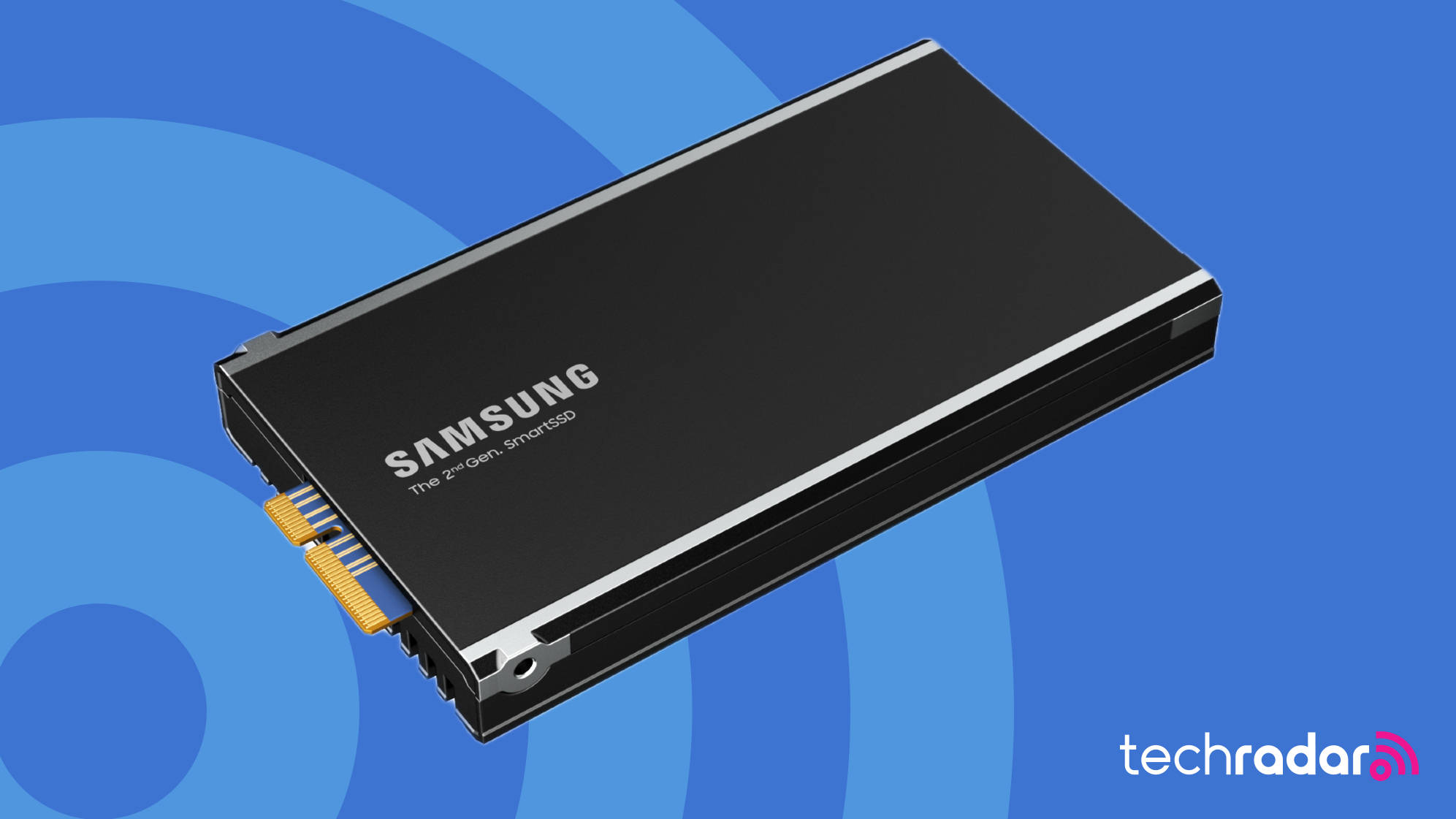Samsung and AMD made a revolutionary SSD together – then it was left to wither in the shadows and nobody knows exactly why
By Desire Athow
Copyright techradar

Skip to main content
Tech Radar Pro
Tech Radar Gaming
Close main menu
the business technology experts
België (Nederlands)
Deutschland
North America
US (English)
Australasia
New Zealand
View Profile
Search TechRadar
Expert Insights
Website builders
Web hosting
Best web hosting
Best office chairs
Best website builder
Best antivirus
Expert Insights
Don’t miss these
No, that’s not a misprint – Sandisk unveils massive 256TB SSD, but it will power the next generation of AI workloads, so don’t think you’ll ever get one
Solidigm confirms 245+ TB SSDs set to launch before end of 2026
Samsung’s biggest rival and Sandisk have come together to standardize High Bandwidth Flash memory – which could mean better AI performance for everyone
After Sandisk, D-Matrix is proposing an intriguing alternative to the big HBM AI puzzle with 10x better performance with 10x better energy efficiency
Huawei released an AI SSD which uses a secret sauce to reduce the need for large amounts of expensive HBM
Towards the Giga IOPS pipedream: How Nvidia wants to reach 100 million IOPS – even if it means inventing totally new types of memory
Storage and memory Holy Grail gets massive boost with new partnership: UltraRAM inches closer to industrial production of NAND and DRAM killer
The world’s fastest SSD has been announced, but it won’t fit in a PC — Micron 9650 is the first PCIe Gen6 SSD and will reach 28GB/s in sequential read
A chip with ‘thousands’ of cores could change the way servers are designed – bringing compute nearer to RAM thanks to CXL is a lightbulb moment
PCIe 6.0 SSDs with up to 512TB capacity and 28GB/s speeds are coming soon – and Meta may be the first to get them
Kiwi storage startup uses proprietary 144TB SSD to hit 230PB storage per 42U rack – but it will cost well over $2 million to get such a system
Next-gen PCIe 6.0 SSD to reach 512GB in capacity and 28GBps in performance, almost 2X faster than PCIe 5.0, but I can’t see it reaching my desktop PC before 2030
Sandisk recruits RISC cofounder, AMD graphics legend to spearhead cheaper rival to HBM — high bandwidth flash could bring SSD-capacities to AI GPUs without the cost
Second 246TB SSD confirmed for 2026 as Micron unveils 122TB 6600 ION PCIe Gen 5 SSD in a bid to replace hard disk drives in data centers
If I wanted to save my entire 4K collection, I’d probably buy this spacious $5550 Samsung 61.44TB SSD
Samsung and AMD made a revolutionary SSD together – then it was left to wither in the shadows and nobody knows exactly why
Desire Athow
16 September 2025
Computational storage drives looked attractive on paper so what happened next?
When you purchase through links on our site, we may earn an affiliate commission. Here’s how it works.
The second generation of Samsung’s SmartSSD, launched in 2022
(Image credit: Samsung)
Samsung used AMD’s Xilinx FPGA to power its SmartSSD storage device
It promised to reduce enterprises’ reliance on servers
Computational storage devices, however, have faded just as Generative AI surged
Samsung came up with the concept of a SmartSSD back in 2018, before generative AI kicked off. This computational storage drive would power server-less computing, bringing compute closer to where data is stored. SmartSSD had NAND, HBM and RDIMM memory sitting next to a FPGA accelerator in the SSD itself. That FPGA was built by Xilinx, which AMD purchased in October 2020.
Fast forward to 2025 and the SmartSSD has all but disappeared from Samsung’s portfolio. You can still buy them from Amazon (and others) under the AMD Xilinx brand (rather than Samsung’s) for $517.70 with a 3.84TB capacity.
The fact that it is a Gen3 SSD and the novel but complicated nature of the hardware made it a difficult sell. Then came the double whammy of COVID-19 and AI; the latter, more than anything else, is probably why Samsung gave up on CSDs.
You may like
No, that’s not a misprint – Sandisk unveils massive 256TB SSD, but it will power the next generation of AI workloads, so don’t think you’ll ever get one
Solidigm confirms 245+ TB SSDs set to launch before end of 2026
Samsung’s biggest rival and Sandisk have come together to standardize High Bandwidth Flash memory – which could mean better AI performance for everyone
Generative AI demanded another kind of computational resource that CSDs simply couldn’t deliver then and while LLMs need SSDs, storage capacity, rather than compute features, was what it was all about.
Put it simply, CSD represented an interesting but niche market, one that’s closer to traditional servers. It was nice but didn’t have the explosive growth potential of AI-related hardware. That’s why I think Samsung mothballed it after its second generation, despite the company positing that “the computational storage market has great potential” in 2022.
What’s next for CSD?
SNIA Computational Storage Standards – YouTube
The dedicated page on SNIA’s website, the group that oversees the standardization of computational storage, shows little progress since the launch, in October 2023, of a CS API. A video released in 2024 by the co-chairs of SNIA’s CS technical working group mentions a version 1.1 that is under development.
One of its staunchest proponents, Scaleflux, changed its “about us” page to omit computational storage in its entirety. Instead, it focusses on delivering products that use CS under the hood. Its CSD5000 enterprise SSD, for example, has a physical capacity of 122.88TB but a logical capacity of 256TB (with a compression ratio of approximately 2:1) mentioned in the small print. That is achieved using onboard compute.
Are you a pro? Subscribe to our newsletter
Sign up to the TechRadar Pro newsletter to get all the top news, opinion, features and guidance your business needs to succeed!
Contact me with news and offers from other Future brandsReceive email from us on behalf of our trusted partners or sponsorsBy submitting your information you agree to the Terms & Conditions and Privacy Policy and are aged 16 or over.
Given the growing importance of AI inference, it would make sense to have some of it done as close as possible to where the data lives, that is on the SSD. With ASICs (application-specific integrated circuits) getting more popular thanks to hyperscalers (Google, Microsoft) and AI companies (OpenAI), the market for enterprise inference-friendly AI SSDs – especially at the edge – could open up sooner rather than later.
You might also like
These are the best NAS devices around
Largest SSDs and hard drives of 2025
We’ve rounded up the best cloud storage services on offer
Desire Athow
Social Links Navigation
Managing Editor, TechRadar Pro
Désiré has been musing and writing about technology during a career spanning four decades. He dabbled in website builders and web hosting when DHTML and frames were in vogue and started narrating about the impact of technology on society just before the start of the Y2K hysteria at the turn of the last millennium.
You must confirm your public display name before commenting
Please logout and then login again, you will then be prompted to enter your display name.
No, that’s not a misprint – Sandisk unveils massive 256TB SSD, but it will power the next generation of AI workloads, so don’t think you’ll ever get one
Solidigm confirms 245+ TB SSDs set to launch before end of 2026
Samsung’s biggest rival and Sandisk have come together to standardize High Bandwidth Flash memory – which could mean better AI performance for everyone
After Sandisk, D-Matrix is proposing an intriguing alternative to the big HBM AI puzzle with 10x better performance with 10x better energy efficiency
Huawei released an AI SSD which uses a secret sauce to reduce the need for large amounts of expensive HBM
Towards the Giga IOPS pipedream: How Nvidia wants to reach 100 million IOPS – even if it means inventing totally new types of memory
Latest in Pro
Adobe Stock celebrates 10th birthday with pay out for contributors and one long-awaited update I think creators will love
How AI fraud Is evolving faster than AP & procurement defenses
Fixing the Online Safety Act: look to betting, not to bans
Google reveals huge $6.8 billion investment in UK ahead of Trump visit
Bags of info stolen from multiple top luxury brands – double check your data now
AI-written software Is booming: can you trust the vibe?
Latest in News
Samsung and AMD made a revolutionary SSD together – then it was left to wither in the shadows and nobody knows exactly why
Not vibing with Liquid Glass in iOS 26? Here’s how to make it easier on the eyes
Sony reveals that physical software only accounted for 3% of PlayStation sales in the last year, only further fuelling the fire that the PS6 will continue the embrace of digital gaming
Xiaomi’s next flagship has a second display on the back – and you won’t believe its iPhone-inspired name
Watch out – now some Pixel 7 and Pixel 7 Pro owners are seeing battery overheating issues
The iPhone 17 Pro series is in high demand – here’s how long you’ll have to wait to get one
LATEST ARTICLES
NYT Connections hints and answers for Wednesday, September 17 (game #829)
Quordle hints and answers for Wednesday, September 17 (game #1332)
NYT Strands hints and answers for Wednesday, September 17 (game #563)
Proton VPN drops to its lowest price of the year – and TechRadar readers get even better value
Adobe Stock celebrates 10th birthday with pay out for contributors and one long-awaited update I think creators will love
TechRadar is part of Future US Inc, an international media group and leading digital publisher. Visit our corporate site.
Contact Future’s experts
Terms and conditions
Privacy policy
Cookies policy
Advertise with us
Web notifications
Accessibility Statement
Future US, Inc. Full 7th Floor, 130 West 42nd Street,
Please login or signup to comment
Please wait…



